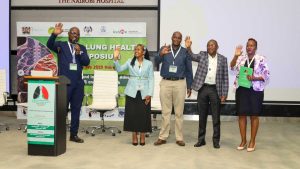The Kenya International Scientific Lung Health Conference (KISLHC) brought together an inspiring assembly of researchers, policymakers, clinicians, and development partners to deliberate on innovations and local realities in tuberculosis (TB) and lung health. The two-day symposium emphasized collaboration, data-driven decision-making, and sustainable health interventions tailored to Kenya’s evolving health landscape.

In her opening remarks, Dr. Nkirote expressed gratitude to the organizing and scientific committees for curating a vibrant program that not only shared knowledge but also fostered meaningful engagement. She highlighted the symposium’s core purpose — to strengthen evidence-based practices, generate new ideas, and deepen partnerships that advance TB and lung health in Kenya and beyond. “This symposium is not just about presentations; it’s about connections, collaboration, and creating solutions that truly impact our people,” she remarked.
Representing the host county, Mueni Litswa, from the Nairobi County leadership, extended a warm welcome to participants, introducing the rallying slogan, “Mapafu Fiti, Maisha Fiti” (Healthy Lungs, Healthy Life). She lauded the ongoing collaboration between the National TB Program, implementing partners, and research institutions that has allowed Nairobi to pioneer integration of chronic lung conditions into TB programs. Mueni emphasized the importance of addressing gaps in diagnostics, forecasting, and resource allocation, especially as donor funding declines, and called for the adoption of digital tools such as electronic medical records to strengthen sustainability and health system integration.
Iban Rono underscored the urgency of local ownership in tackling TB and lung diseases. He reiterated that the fight against TB is a collective national responsibility that extends beyond the government to include communities, civil society, and development partners. He urged stakeholders to approach TB not as a distant public health issue but as a personal and national priority, noting that “every third person in Kenya could potentially be affected.” He further called for innovative solutions, enhanced research, and targeted resource mobilization to accelerate progress toward the country’s End TB goals.
“We need to integrate and bring everybody on board, have the buy-in, this is the only way this thing will work. As much as we are saying ‘don’t leave any TB patient behind,’ we must also not leave any healthcare worker behind. Whether you are a community volunteer, a nurse, or a specialist, as long as you’re involved in TB and lung healthcare, we must hold each other so we can hold the patient better.” – Dr. Immaculate Kathure – Ag. Head, Division of Tuberculosis, Leprosy and Other Lung Disease.
The symposium’s interactive spirit was evident through its engaging and energizing sessions, with participants actively contributing ideas on improving care delivery, data use, and cross-sector collaboration. The event set the tone for Kenya’s future in lung health, one driven by innovation, inclusivity, and collective action.
As the curtains closed on the KISLHC, one message resonated throughout the sessions: Kenya’s fight against TB and chronic lung diseases must be powered by innovation, sustained partnerships, and a shared commitment to healthier lungs and healthier lives.
“Mapafu Fiti, Maisha Fiti.”
